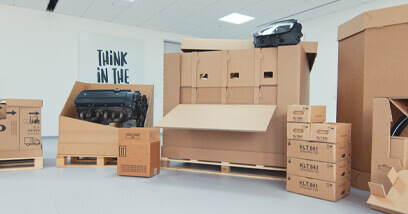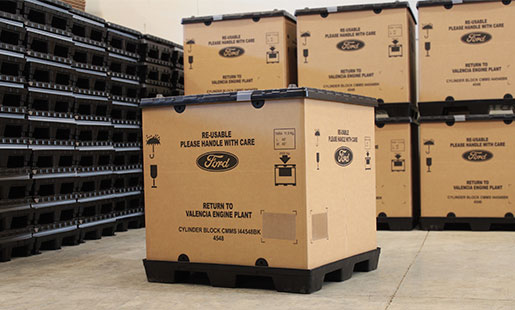Metallic May: Industrial Metal Packaging Solutions Redefined
Reliable Industrial Recycling Solutions for Sustainable Packaging: A Comprehensive Guide
In today's progressively environmentally-conscious globe, the demand for lasting product packaging options has actually never ever been higher. To meet this need, companies across markets are proactively looking for reliable commercial recycling remedies. Browsing the complicated landscape of lasting packaging can be challenging without an extensive guide. That's where this extensive guide on effective industrial recycling remedies for lasting product packaging can be found in. By checking out crucial areas such as packaging material option, making for recyclability, applying reusing facilities, collaborating with recycling companions, and monitoring and determining recycling success, this overview will certainly furnish you with the understanding and tools required to make informed choices and drive positive change within your company. Whether you're a product packaging expert, sustainability manager, or merely thinking about the topic, this guide will certainly supply important insights and approaches to aid you browse the world of sustainable product packaging.
Product Packaging Product Selection
The selection of packaging materials plays an important duty in ensuring the sustainability of industrial recycling solutions. The choice of materials is key in minimizing environmental impact and maximizing recycling performance when it comes to lasting product packaging. Selecting the right products can help in reducing waste generation, conserve sources, and advertise a round economy.
One essential factor to consider in packaging product choice is recyclability - processing company. Materials that can be conveniently recycled and incorporated back right into the manufacturing cycle are favored. For instance, materials like cardboard, paper, glass, and particular sorts of plastics can be recycled multiple times without shedding their top quality. On the various other hand, materials that are hard to recycle, such as mixed plastics or non-recyclable compounds, can create obstacles for the recycling procedure and may wind up in burners or landfills.
An additional consideration is the usage of eco-friendly and eco-friendly materials. Packaging made from renewable energies, such as plant-based plastics or biopolymers, can help in reducing reliance on fossil gas and reduce climate modification. Furthermore, eco-friendly materials break down naturally with time, decreasing the buildup of waste in landfills.
Additionally, the weight and volume of packaging materials must be minimized to decrease transportation expenses and power intake. Light-weight products not only require fewer resources during manufacturing however additionally add to lower carbon emissions during transportation.
Designing for Recyclability
Product packaging developers ought to prioritize the use of products that are commonly accepted for reusing and have actually established recycling facilities. Products such as glass, light weight aluminum, and specific types of plastic, like PET and HDPE, are generally reused and ought to be preferred over products that are hard or costly to recycle.
Another crucial factor to consider in developing for recyclability is the elimination of unneeded components or products. By reducing the variety of layers, finishes, and additional parts, packaging can be made less complex and much easier to recycle. Furthermore, designers need to aim to lower using combined materials, as they can make complex the recycling procedure.

Implementing Recycling Framework
Effective application of recycling facilities is critical for the success of industrial reusing services. Without appropriate framework in location, the reusing process ends up being ineffective and inefficient, impeding the general goal of sustainable product packaging.
To implement recycling framework effectively, a number of vital factors need to be taken into consideration. There must be an efficient collection system that facilitates the separation and collection of recyclable materials. This can include assigned reusing containers in public rooms, along with partnerships with waste management companies for curbside pickup and sorting.
When gathered, the recyclable products require to be moved to reusing facilities in a timely manner. This requires efficient logistics and transportation networks, guaranteeing that the materials reach the suitable facilities right away.
At the recycling facilities, advanced sorting and processing technologies should be in place to divide different sorts of products successfully. This consists of using automated arranging devices, optical scanners, and manual sorting techniques.
Furthermore, there should be a durable market need for recycled products. This can be accomplished through collaborations with manufacturers and industries that make use of recycled products in their manufacturing processes. Creating a steady market for recycled products incentivizes the recycling industry and advertises the round economic situation.
Working Together With Recycling Allies

One secret facet of working together with recycling partners is the establishment of clear interaction channels. It is necessary to establish open lines of communication to help with the exchange of info, updates, and feedback. This allows both celebrations to remain notified concerning the development of reusing initiatives and address any obstacles or problems that might occur.
In addition, cooperation can involve collaborations in implementing and creating reusing programs. Recycling companions can offer why not find out more important understandings and advice in establishing effective collection systems and figuring out one of the most ideal recycling technologies. By interacting, companies and recycling partners can maximize the reusing process and minimize waste.
Moreover, collaboration can expand beyond the functional elements of reusing. It can additionally include campaigning for and education and learning efforts. By joining forces, organizations and recycling companions can increase awareness concerning the significance of recycling and advertise the fostering of lasting product packaging practices amongst consumers and various other stakeholders.
Monitoring and Measuring Recycling Success
To make certain the effectiveness of commercial reusing remedies and the accomplishment of sustainable packaging objectives, it is crucial for organizations and their recycling partners to establish an extensive system for tracking and determining reusing success (plastic container manufacturer). Tracking and gauging reusing success permits companies to assess the influence of their reusing efforts, recognize areas for enhancement, and set meaningful targets for future development
One method to track reusing success is via using data collection and analysis devices. By gathering information on the quantity of product packaging waste created, the percent of waste that is recycled, and the sorts of products being recycled, companies can gain important insights right into their recycling performance. This information can after that be evaluated to identify fads, patterns, and locations of ineffectiveness.
An additional crucial aspect of tracking and determining recycling success is developing clear and standard metrics. This permits organizations to contrast their performance versus industry criteria and track their progression over time. Metrics such as reusing rates, waste diversion rates, and greenhouse gas emissions can offer a quantitative procedure of a business's reusing success.

Verdict
To conclude, applying efficient industrial recycling options for lasting packaging requires mindful consideration of packaging material option, creating for recyclability, implementing reusing facilities, collaborating with reusing partners, and monitoring and determining reusing success. By integrating these practices, organizations can add to an extra sustainable and environmentally-friendly technique to packaging, lowering waste and promoting the round economy.
By discovering essential locations such as packaging product choice, designing for recyclability, applying recycling facilities, teaming up with recycling companions, and monitoring and measuring reusing success, this overview will furnish you with the knowledge and tools needed to make enlightened decisions and drive favorable adjustment within your organization. Packaging developers need to prioritize the use of products that are widely accepted for reusing and have actually developed recycling facilities.Cooperation with reusing partners is necessary for the effective implementation of industrial recycling options and the success of lasting packaging goals. By joining forces, services and reusing partners can increase recognition concerning the importance of recycling and her explanation promote the adoption of sustainable packaging methods amongst customers and other stakeholders.
By collecting information on the quantity of product packaging waste created, the percentage of waste that is recycled, Homepage and the types of materials being recycled, businesses can acquire useful insights into their reusing efficiency.